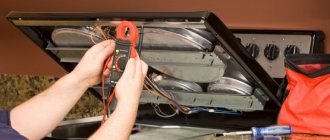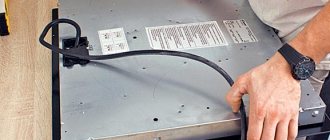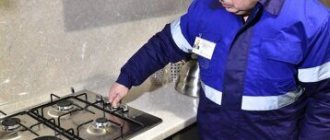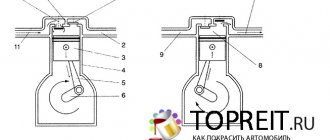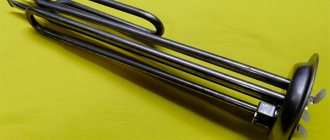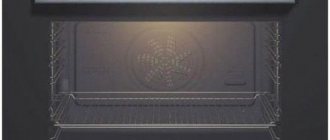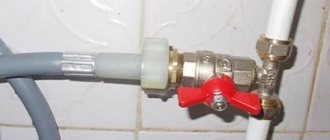There are more and more appliances in the house, and willy-nilly you begin to think that it would be nice to be able to fix even simple damage yourself. To help, this article will discuss a simple DIY hob repair. Please note - if the equipment is under warranty, it is better not to mess with it at all. All that is possible in this case is to replace the power cord. In other cases, it is better to contact the service. Well, if there is no warranty for a long time, you can try to repair the hob yourself.
Types of hobs
The hob (surface) is the name given to electric and induction hobs with a ceramic or glass-ceramic coating. Under this coating there are heating elements - burners. These burners can be of different types:
- Induction. They use the principle of electromagnetic induction. For the correct operation of this type of equipment, correctly selected cookware is important, since it forms a single electrical oscillatory circuit with the burner, which generates heat. Without dishes on the burner, it simply does not turn on.
Without cookware (correctly selected), the induction cooker does not work
Spiral burner - the most common option
Halogen heats up in a few seconds
As you can see, the burners are different and different processes are used for cooking, but the general structure of the hobs is the same. To make it easier to look for breakdowns when repairing a hob, you need to know how the equipment works.
ECH. Nuances of use.
In principle, there is only one nuance - these burners do not like overheating. Therefore, you should try not to turn on the burner at maximum power if there is nothing on it. That is, if you “like” to heat yourself with burners in the spring-autumn period, then you should not turn them on at full power; half the power will be enough.
Let's summarize. This article discusses the EKCH burner, that is, cast iron, as the most common, but the principle itself - stepwise power adjustment through the use of several spirals in one burner - can also be found in another design. The purpose of this article is to give you an understanding of the operating principle of such burners.
Best wishes, Me!
Hob device
The main components of the hob are the burners and the control panel. Each burner has contacts for connection and a control relay (thermal relay). Through contacts, the burner is connected to the control panel, and the thermostat monitors the surface heating temperature and turns off/on the power. Problems with burners are most often associated with incorrect operation of the remote control or loose/burnt contacts.
Burner structure of a glass-ceramic hob
The control unit and the burners are connected to each other using wires. This is another source of problems. You can deal with breakdowns of these devices without special skills. You will need a multimeter and a soldering iron. Because if any element is damaged, you will need to unsolder it, buy an equally good one, and install it in its place. When carrying out this work, you should not rely on memory. It's best to take pictures of everything before starting work. Later in the process, also take photos periodically. In any case, every time before you change anything in a node, take a photo of it. It will be easier to install a new element or replace the old one.
General structure of an electric hob
The most difficult thing to understand is the breakdown of the control unit. This requires serious knowledge of circuit design. If they are not there, it is better to consult a specialist on this issue.
The location of the parts and their shape may be different and depend on the manufacturer and model, but in general the structure of the hob with electric burners is very similar.
Diagnostics of heating elements
Heating elements (heating elements) are checked with a multimeter, for which their resistance is measured. It is within hundreds of ohms. Low resistance indicates a short circuit in the heating element (in this case, the automatic power switch of the electric stove should be turned off), infinity indicates a break in the element. In both cases it will have to be changed.
Spiral heating element
The burners may have 4 outlets, in which case they contain two heating elements. This is necessary for stepwise power adjustment. The elements have different power and different resistance.
The heating element must not have electrical connection with the housing. If it is detected, the element is changed.
Burner switch
Control problems
The most difficult case is problems with the control board. There is little you can do on your own. How to understand that the control unit is at fault? There is no signal when pressing buttons. If the power turns on, but then there are no sounds or visible changes in status when setting operating modes, most likely there is a control problem. In this case, repairing the hob consists of simple steps.
If the stove does not listen to you, first thoroughly clean the surface - dirt can cause this behavior. Next, you should check your power settings. If the mains voltage is too low, the control operation may be affected.
The control panel is the most difficult area to repair
If the voltage is normal and there are no changes, we try to restart the programs. To do this, turn off the power to the hob. If it is connected through a plug with a socket, remove the plug. Switching off with a button is not enough. If you connected the stove through the terminal block, it is easier to turn off the machine on the panel. The stove must remain in a de-energized state for at least 10 minutes. Then you can turn it on and try again. If there was a simple control glitch, this helps, but if the problem is more serious, it doesn’t. If all actions do not bring results, call a specialist.
Induction option
When an electric stove with an induction hob does not work, a possible reason for this may be the mains switch or a special fuse - it melts when the voltage increases, turning off the entire electrical circuit. For various reasons, the contacts between the control unit and the power board or between it and the touch panel may not turn on, due to oxidation or carbon deposits. Only a specialist can understand all the complexities - here you need to change the burner unit or the touch control panel.
Poor heating
Weak heating of the surface of the induction burner of an electric stove can occur due to the fact that the bottom of the cookware is much smaller than the diameter of the latter, or there is not enough contact - cookware with a deformed bottom. Smart burners do not heat up in this case. To eliminate the malfunction, you must use only special cookware that is suitable for an induction hob.
Another reason for poor heating is a loose fit of the burner block on the inside of the glass-ceramic stove. In this case, it is necessary to adjust the springs of the clamping device. This can also happen if the induction winding is severely overheated, which happens extremely rarely.
The burner doesn't work
Very often, such malfunctions in the operation of induction burners occur due to the fault of the user:
- the diameter of the bottom of the cookware should be at least 12 cm - this will ensure sufficient contact area with the hob;
- the thickness of the bottom should be in the range of 2-6 mm;
- First, select a burner, place dishes on it, and then set the power of the cooking mode.
If the operating rules are followed and the recommended utensils are used, the reason for the failure may be as follows:
- the temperature sensor has failed;
- there is no heating on the pair of burners on the left - their connection to the power board and control unit is broken;
- when the same thing happens with the right block - there is no contact in the terminal box, you need to check the fuse; if it is blown, install a new one.
In case of such malfunctions, you need to call a service technician, and not open the electric stove - only he can make the correct diagnostics to determine the problem with the power supply, control unit or the burners themselves. Minor repairs of electric stoves require minimal skills and knowledge; in case of major breakdowns, contact professionals.
Do-it-yourself hob repair: what to do if the burner does not turn on
If the burner does not turn on, there may be several reasons:
- burning or weakening of contacts;
- thermal relay malfunction;
- problems with the wires going to this burner;
- heating element burnout.
All these problems can be fixed with your own hands. Repairing a hob begins with disassembling . It must be unplugged and disconnected from the countertop. Transfer the hob to a table covered with a clean cloth, turn it glass side down, unscrew the fastening bolts located on the sides, carefully, holding the ceramics, turn them over and remove the ceramic panel. This way we get access to the insides and can repair the hob with our own hands.
We begin repairing the hob: remove the glass-ceramic hob
The first thing to do is to inspect the wires that go to the non-working burner, check the contacts . Violation of the integrity of the wires and burning of contacts is a very common cause of breakdown. In private homes, wiring can be chewed by mice, and contacts can burn due to poor quality assembly. If everything is visually in order, we pull the wires, checking the quality of the contact. If traces of soot are visible somewhere, we disassemble the contact, clean it to bare metal, pack it back, install it and clamp it well. The last stage of checking wiring and contacts is measurement. We take a multimeter, check the wires for integrity (we call) and for insulation breakdown (on the body and between each other). Read how to use a multimeter here.
Read also: Homemade boat motor from a screwdriver
If no deviations are found in the wiring, inspect the thermal relay . It is located next to the burner (electromechanical), covered with a plastic cover. In some models, the relays are located in the control unit (electronic). Then, in order to determine which relay is responsible for heating the burner we need, we track it through the wires.
On some models, thermal relays are installed on the control board
If the relay is electromechanical, pry off its cover with a screwdriver and inspect the contacts. There may be charred, bent or fused contacts. It must be replaced. If the relay is electronic, there is no point in opening it. We measure its resistance and compare it with the serviceable ones standing nearby. There is a deviation - a replacement is needed.
If everything is fine with the relay, the burner may have burned out . To check, measure the resistance. If it is large or tends to infinity (break), the problem is in the spiral, heating element, etc. To find a replacement, look for the burner number (written on its body). With this number we go to the store or search on the Internet. Next, repair the hob - replacing the burnt burner. We unsolder all the wires, remove them, install a new one, and connect.
The fire goes out after being ignited
There are times when a properly working gas stove suddenly begins to give surprises. Let's say that you turn on the gas supply, it ignites, and after releasing the handle, it immediately goes out. Such symptoms indicate a breakdown of the thermocouple - a sensor that turns on the supply of a combustible mixture.
A thermocouple works like this: when heated, it generates alternating current, which magnetizes the solenoid valve. The valve, on its part, opens and gas flows freely into the burner. If the heating of the thermocouple ends, the electrical pulse disappears and the valve closes the flow. Similarly, if after opening the tap to turn on the gas and ignite it with an electric candle, the combustion immediately ends, this means that the solenoid valve has tripped and cut off the supply of the combustible mixture.
Repairing a gas stove in the event of such a breakdown is very simple.
- First of all, you will need to remove all the handles and the top panel of the stove by unscrewing the bolts located on the sides of the lid and under the burners (stove designs are varied, based on this, and the locations of the fasteners may vary).
- After screwing in the fasteners, remove the top cover of the unit.
In the same way, you can repair the Hephaestus, Ardo, Brest and Hansa stoves if the thermocouple breaks down.
You also need to remember about safety precautions; before repairing a gas stove, you should turn it off from the electrical network.
Button failure
Sometimes the reason for a spark plug not working can be a faulty button. This breakdown during repairs of burning stoves or other brands can be determined by transferring the wires (after removing the top panel of the device in advance) to another button on the gas stove. If the ignition works when you open the burner tap, then you need to replace the broken button.
If it doesn't turn on at all
If the equipment does not turn on at all, check the voltage immediately . If the voltage is low, the hob may not turn on. To avoid such situations in the future, it is advisable to install a stabilizer. This will significantly extend the life of the equipment, since electronics are very sensitive to power quality, and electronics are the most difficult to repair (and more expensive).
If the voltage is normal, we will continue repairing the hob by inspecting the power cord . Oddly enough, many breakdowns are associated with its damage - frayed, bent, crushed, insulation burst/melted, etc. First, we inspect the cord (disconnecting it from the network), then we check for the integrity of the wires and for insulation breakdown (each wire to the ground and to each other).
What to do if the hob does not turn on? First of all, check the cord and contacts
The next step is to check the contact in the terminal block . A loose or oxidized contact can also cause the hob to not turn on. What to do in this case? Unscrew the contact, clean it from oxides, and tighten it well again.
If the stove still shows no signs of life, find the fuse . It stands at the entrance, burns out during power surges - to protect more expensive parts from damage. It can look different, but most often it is a glass or ceramic tube with metal caps on the edges. Some types of fuses are shown in the photo below. There may be such options.
Types of fuses
We found the fuse, then take a multimeter and measure its resistance. It should be small. If the device shows an open circuit (infinitely high resistance), the fuse has blown. Another way is to put the multimeter in test mode and touch the probes to both ends of the fuse. The device is silent - it has burned out.
We take out the blown fuse and replace it with a similar one. Exactly a similar one - with the same parameters (indicated on the case). It is not recommended to install a “bug” or one with less sensitivity - with the next power surge the breakdowns will be much more serious.
The only easy check left is to check whether the power is reaching the control unit from the terminal block. Maybe the wiring is damaged or the contact is loose/lost somewhere. Do this again using a multimeter. We check the wires for integrity (you can do this by testing, you can by measuring the resistance) and the presence of insulation breakdown (on the body and between each other). If all parameters are normal, you can turn on the power and carefully measure the voltage at the input of the control unit. The voltage is normal, but the hob still does not turn on - the problem is in the control unit. Further repairs to the hob are related to this unit.
Glass-ceramic stoves and hobs have firmly entered our lives quite recently, but are already in high demand due to their good performance characteristics. The main advantages of stoves with glass-ceramic hobs include practicality, ease of use and reliability. But, like any equipment, kitchen stoves often break down. And this applies not only to glass-ceramic stoves, but also to other types of stoves.
The weakest point of glass-ceramic stoves is its hob. If a heavy object is dropped on it, it may crack and in this case the hob will need to be replaced. In addition, a glass-ceramic stove consists of a huge number of interconnected components and assemblies, one of which can fail at any time.
If your glass-ceramic stove has stopped working, does not heat or fry food well, then this is a good reason to contact a service center. You can leave a request for a technician to visit you by calling the suggested phone number 8 (495) 228-39-79 . In this case, you need to indicate what exactly happened to the stove, as well as name its make and model. Our craftsmen have extensive experience, which means you can be confident in their professionalism. We carry out repairs of glass-ceramic stoves at home in Moscow inexpensively, efficiently and quickly.
ECH. Electrical diagram.
The power of the elements may not be the same. Quite often there is a diagram on the underside of the burner in the form of an imprint. However, what you need to know so that you can check all the spirals and determine the scheme (because it may differ from the one proposed, although most often it looks exactly like this). So, if you use a multimeter in dialing mode (or checking resistance) to dial pins 2 and 4, then you will get the highest resistance, because in this chain all three spirals will be connected in series, and with a serial connection, the resistances are summed up. If you close 4 and 3 together, and then 1 and 2 and measure the resistance between these pairs of contacts, you will get the smallest resistance, because all the spirals will be connected in parallel. And in a parallel connection of resistances, the total resistance will be less than the smallest. Accordingly, you can measure the resistance of each spiral:
- No. 1 - contacts 3 and 2
- No. 2 - contacts 3 and 1
- No. 3 - pins 1 and 4
If any of the spirals burns out, then the burner in some positions will not work at all, and in others it will not develop maximum power.
Typical failures of glass-ceramic plates and their causes
Glass-ceramic stoves and hobs break mainly due to careless handling and natural wear of parts. One of their most common faults is cracks in the panels. In this situation, it is necessary to replace the panel as soon as possible. Our craftsmen, who encounter similar breakdowns every day, can perform this work efficiently and quickly.
Repair of glass-ceramic electric stoves by our workers is carried out directly at home, which significantly saves your effort, nerves and money on transporting it to the workshop. If your stove requires complex and time-consuming repairs, then we can transport it to our service center ourselves, since in some cases special equipment may be needed to fix the breakdown.
Panel replacement is usually completed within a few hours. In some cases, the panel replacement period may be increased based on the volume and complexity of the work performed. We repair glass-ceramic stoves of all Russian and foreign manufacturers, including the brands Siemens, Hansa, Gorenje, Bosch and others.
Read also: What is the frequency of checking power tools?
The second most common failure of electric stoves is burnt-out burners. In this case, the spiral needs to be replaced. Ceramic panels have a rather complex structure of heating elements, so it is not recommended to do any work to replace or repair them yourself. Only a specialist can cope with such work. You can submit a request for a technician to visit you at any time and day convenient for you. We guarantee high-quality slab repairs at an affordable price.
Cost of specialist work
If you are hesitant to do the repairs yourself, you can hire a third-party specialist. The cost of calling a household appliance electrician will depend on the nature of the breakdown.
Let's consider the approximate prices that are relevant in the market for these services in 2022:
- Primary diagnostics and calling a specialist. From 500 to 1000 rubles. Some repairmen do free diagnostics if they are paid for further repairs.
- Replacing the central unit. From 1800 rubles, excluding the cost of the part.
- Repair/replacement of heating switch or power regulator. From 1100 rubles excluding the cost of the part (if it is replaced).
- Replacing the ten. From 850 rubles, excluding the cost of the part.
All prices are based on the average cost of services in Moscow and the Moscow region. When calling a technician, you need to take into account the complexity of the breakdown. For example, if your central control unit has failed, it may make sense to refuse repairs, since the cost of a new part can be 50-60% of the price of a new electric stove.
Assessing the condition of the oven yourself is not that difficult. The main thing is to follow the order of disassembly. When removing the hob, you need to be especially careful with the wires. It is best to mark the order of their connection using paper stickers. If you doubt your own abilities, call a household appliance repair specialist.
How is glass ceramic hob repaired?
Repair of an electric stove with a glass-ceramic panel is carried out by our specialists using professional equipment, tools and original spare parts. In addition, in our work we use high-quality consumables. At the same time, the cost of the work is not overpriced and is acceptable for all people who want to repair the stove efficiently and in the shortest possible time without unnecessary costs and loss of time. Most often, glass-ceramic hobs require replacement:
In case of any breakdown of the slab, a full diagnosis and visual inspection is carried out. After identifying a malfunction, the technician repairs or replaces the worn part. Then the functionality of the equipment is checked. In addition, you can always get advice on the correct use of equipment.
We repair and replace parts of glass-ceramic stoves of all brands. For example, Zanussi, Miele, Electrolux, Ariston and others. Each of our service technicians always has with him all the necessary spare parts that may be useful during stove repairs. You can contact us at the specified telephone number 8 . We work every day without breaks or weekends, so anyone can call a technician to your home at any time. To do this, you need to leave a request and specify the type of malfunction.
Today, the popularity of household appliances powered by electricity is constantly growing, but minor breakdowns sometimes occur during operation. An electric stove is present in every modern kitchen - it is the heart of this room. When a kitchen assistant breaks down, many home craftsmen are interested in whether it is possible to repair an electric stove with their own hands?
Preventive actions
It is possible to ensure long-term uninterrupted operation of a household appliance by observing proper care and following the requirements set out in the operating instructions.
- The glass surfaces of the electric stove are maintained without the use of abrasive materials.
- Every time after cooking, clean the stove with soapy water and wipe dry.
- Do not leave the stove turned on unattended for a long time to avoid igniting objects located nearby.
- Use cookware with a diameter that matches the size of the burner.
- Inspect the stove and components in a timely manner for damage and possible malfunctions, and carry out repairs in a timely manner.
- Do not place cold dishes on a hot burner.
- Avoid getting liquid, salt and sugar on the glass-ceramic hob, otherwise it will quickly become unusable.
- When starting repairs, the stove is first de-energized, and the contacts are checked for residual current with a multimeter.
- Protect the stove from mechanical damage.
- Before using for the first time, carefully read the operating instructions.
- Do not use household appliances for purposes other than their intended purpose.
What is needed for repair
Firstly, a home craftsman who decides to repair an electric stove himself must at least understand electrical appliances, know the basic basics of electrical engineering and safety rules when carrying out this type of work. Secondly, you need confidence that you can perform such complex repairs, and most importantly, find and eliminate the main cause of the breakdown. Thirdly, it is necessary to prepare a special tool.
When dismantling electric stoves, you will need screwdrivers for various purposes: cross-head or slotted, with different thicknesses, so-called blades by specialists. You will definitely need wrenches - open-end and socket wrenches, pliers, wire cutters. For internal work in the product body, you will need a soldering iron, side cutters, insulating tape and, of course, a special device for measuring voltage and resistance.
The photo shows only an approximate set of the necessary tools - during work, the range of tools used tends to expand significantly.
Design and main components of an electric stove
The electric stove looks very impressive - it is a complex household appliance, but its design is quite simple, and all the main working elements are located in a special heat-resistant case, which is made of stainless steel.
The operating principle is similar to all electrical household appliances: current passing through heating elements (heating elements) heats them to a given temperature. The stove has several burners on the hob, and their number varies: a minimum of two, and the standard is 4 pieces. For example, the budget electric stove Mechta 15M has only two burners and a small oven, while the product of Belarusian engineers Hephaestus has a standard set of burners and a large oven.
The structure of the burners is quite diverse. The classics are burners on an enamel hob with heating elements inside, modern ones are solid ceramic surfaces with various types of heaters built into them. Let's look at the main types of burners.
- Old domestic versions are equipped with cast iron products; they heat up slowly and also cool down, creating a steam effect in the kitchen, but they are resistant to moisture and high temperatures.
- Tubular spirals - they are made of a hollow tube; when heated, such devices not only give off heat, but also promote the circulation of warm air inside their body, which significantly increases their efficiency. These products are very difficult to repair yourself.
- Ceramic burners are very simple in design, they are easy to repair at home - a nichrome spiral is placed in special cells in a circle and secured. Modern models increasingly use glass-ceramic solid plates - they are more durable and easy to clean.
- Halogen devices are special burners with a similar emitter that are installed in different places on the hob. A stove with such burners provides fast heating, in a second, and low energy consumption, so they are the most economical, but only professional craftsmen can carry out repairs.
All models of modern stoves use a special cross-section power wire to transmit current to the burners; in addition, they are connected to regulators and thermostats, ensuring their protection from overheating.
In different models, the heating level is controlled in different ways: by manually changing the cooking mode or by special timers and alarms that monitor.
ECH. Express burner
There is a variety of ECH burners, which are labeled as express burners. You can identify them by the red circle in the center of the burner. Inside this burner there is a high-power spiral with a built-in thermal relay. Such burners heat up faster, and when they reach maximum mode, the thermal relay turns off the high-power coil, thereby preventing overheating of the burner. The switching circuit is no different from conventional burners. What to choose, regular or express, is up to you. I personally would prefer a regular one, because the fewer connections there are, the lower the risk of breakage.
Common faults
During operation of electric stoves, users may encounter such typical malfunctions.
- Sometimes, when you turn on the product, a burning smell appears - you need to turn off the stove and inspect the burners, on which there could be remains of burnt food, which can be easily removed. When the smell of burnt plastic or rubber appears, you need to call a professional.
- The heating element does not heat up - this is the fault of the burner or the connecting wires, but first you need to check the controls, maybe the contact has come loose.
- It is impossible to set the optimal heating temperature of the burner - the switch needs to be repaired.
- The burner does not heat up - if you have a coil inside, it often ruptures due to overheating or moisture. In this case, repairing the electric stove is very simple - replace the spiral, that’s all the repair is.
- The oven is not working well - you need to ring the heating elements, this is 100% their fault, replacement is required, because they cannot be repaired.
Attention! If you connected the electric stove yourself, then no service will do the repair for free - you have lost the right to warranty service.
Oven failure
Housewives who often use baking as a cooking method may encounter a malfunction when one oven in an electric stove does not work.
- No backlight. The reason is that there is no contact between the supply wire and the power button. A burnt-out light bulb most likely just needs to be replaced.
- The fan is not working. The convection function, which requires the presence of a fan, is checked using special diagnostic equipment. As a result, the fan is changed or the control unit is repaired.
- The heating element does not heat up. Inactivity of the electric heater or poor heating of the oven indicates that the heating element has exhausted its resource. Needs replacement.
The easiest way to tell why the stove does not turn on is after a short circuit. It almost always leads to failure of the heating equipment.
Troubleshooting algorithm
The process of finding equipment failure does not depend on the product model and the type of hob or burners installed on it.
Read also: Impact drilling rigs
- First, use a voltmeter to check the voltage. You should not exclude the possibility that the circuit breaker has tripped; the insulation of the wiring may be broken or the reason may lie in the socket. If this is the case, then you need to disassemble it and clarify the reason.
- If the indicator lights up on the control panel and the stove does not work, then there is no current supply to the burners, which means you need to disassemble the stove.
- You should check the proper operation of the mechanical or electronic control unit - measure the current flow to the terminals of the burners with the device.
- Check the heating element of each burner to find a burnt-out coil.
- Inspect all temperature sensors, relays and various regulators.
Our task is to find the malfunction and localize the resulting problem. After following all the recommendations, you will discover the cause of the equipment failure, and we will tell you how to fix it a little later.
Socket, plug
The problem may not be with the stove itself, but with the socket or plug. The first can be checked by connecting another electrical appliance, for example, a kettle. When choosing a socket, you should pay attention to the rated current. If it differs from that indicated on the machine, the wiring may melt or even catch fire. For a single-phase network, a classic 32-amp outlet is more than enough.
The chrome elements of the fork should be clean and free of any signs of burning. If there are any, then it must be cleaned, and in difficult cases, replaced. The same rule applies here: buy a plug with an eye on the rated current of the machine.
We disassemble the product
Models of slabs vary not only in external shape, but also in size and design - it is impossible to describe a disassembly algorithm that will fit all products. A common factor for all is the presence of a thermal insulation layer - you need to work with it with extreme caution. Users should be aware that asbestos dust from gaskets under the burners in older models is very harmful to health - take this fact into account when dismantling archaic stoves.
First, the hob is dismantled - it is attached with screws; if you unscrew them, it can be easily removed. Under it there are burners, leading wires to them and mechanical temperature controllers, which are located on the front panel.
All this must be dismantled in order to get to the lower part, where the oven heating elements are located.
For a modern electric stove with a glass-ceramic hob, disassembling the housing for repairs will be different - in order to get inside, you just need to remove the top panel.
Important! Repair of glass-ceramic hobs is carried out only by service center specialists - amateurs with superficial knowledge and lack of experience are better off not touching such complex equipment.
Advice from the experts
- When unscrewing the nut from the pin, apply a small amount of oil to the pin for ease of movement.
- When disconnecting the wires with spring tips from the faulty burner, attach pieces of paper with information about which wiring belongs to which connector.
- Entrust the replacement of parts of an electric stove with a glass-ceramic hob to the specialists from the service center. For other types of slabs, it is possible to use improvised materials for repairs, but branded components are better.
- The burners in the old stove are replaced with more modern ones: this simplifies the search for new parts.
- Before disassembling, the plate is first inspected to determine the cause of the malfunction, for example, remaining wire, carbon accumulation on the contacts, etc.
To avoid possible breakdowns, a preventive inspection of the technical condition of the household unit is carried out annually. Following safety rules, possessing the basics of electrical engineering, and armed with the necessary tools, they repair components and parts of electric stoves.
Troubleshooting
Below are common problems with electric stoves. Some of them can be fixed on your own, others require professional diagnosis and repair.
Burner not working
If you have a stove with burners, then to change them you need to follow this method.
- Unscrew the nut and remove the grounding.
- Under it there may be a ring or bracket that presses the part to the base.
- The burner is attached with a threaded connection or simply inserted into a special hole. In the first option, we lubricate the thread with oil and carefully try to unscrew it from the body; in the second case, we pry it with a screwdriver and remove it.
- If the model is old, then it is better to immediately replace the burnt-out burners with modern and economical models that are suitable in size.
- If the burners are in good condition, then the cause of the failure is in the control unit - a large current passes through the mechanical regulators, and carbon deposits can form on the delicate contacts, which can be cleaned with fine sandpaper.
Heat switch
Here are step-by-step instructions on how to repair or replace the switch on electric ranges.
- If there are no clicks when turning the regulator, this indicates that it is faulty.
- There is an original way to check its condition: put the regulator in the middle position, apply voltage to the stove, the automatic protection should work - turn on and off after 30 seconds.
- Before removing the handles, you must study the instructions - on some models they cannot be disassembled (Gefest, Kaiser).
- First, remove the control knobs from the outside, then unscrew the front panel.
- There is a bar underneath that needs to be removed to get to the broken regulator.
Electronic control unit
If you cannot hear a click when the relay is turned on, then you need to check the presence of a signal - if it is absent, the reason lies in the microprocessor itself or the output cascade. To repair an electronic unit, you need to have a circuit diagram and understand the complexities of radio engineering . If you don’t have the knowledge and skills, then it’s better to turn to specialists - otherwise you’ll have to buy a new electric stove.
Modern electric stoves with heating elements quite often use a cascade-type burner heating thermostat.
Power regulator
Sometimes a regulator breaks down and an identical replacement can be found. Experienced professionals advise installing a triac type of such a device, but you need to take it with a reserve of power and current. In some models it is installed on the same board along with the radiator. When the stove burner operates at maximum, and the heating adjustment cannot be changed, this indicates that the regulator has failed for an unknown reason - it urgently needs to be replaced.
Every user should understand that modern household appliances are crammed with electronics; each model has its own nuance of manufacturing and control, which is different from others - mechanical or electronic. Outside intervention without special knowledge and skills can negatively affect the delicate filling of electric stoves.
If you have a simple stove with burners on an enamel hob, then you can repair it yourself by first watching the video:
Checking other nodes
Modern technology is provided with more reliable protection, unlike models of older generations. If the heating element malfunctions, the operation of the electric stove may be completely blocked. To rule out a problem with the burner, you should check several main components.
Circuit breakers
One of the most common problems - power surges - lead to blown fuses. They look different. Most often this is a small part with a glass or ceramic body with thick contacts at the ends.
Thermal fuse for Hansa cooker
You can check their performance using a multimeter: if the resistance is barely visible, then everything is in order, otherwise we replace them with new ones. Fortunately, they are inexpensive and are sold in any electronics and household appliances store.
It is very important to select the correct fuse. If the element is less sensitive than necessary, it will burn constantly. And overestimated indicators can cause burnout of the main elements of the electric stove.
The ideal option is to take the old fuse with you when going for a new one.
Machine
If the machine in the control panel constantly knocks out when you turn on the stove, then the whole point is a short circuit. The wires could melt and become twisted together. You should inspect the electrical wiring of the stove, test suspicious areas with a multimeter and eliminate the fault.
Sometimes the problem lies in the machine itself. For example, if there was a replacement with an option with a lower load power. In this case, you need to do the same as with a fuse: take it with you to the store and buy a solution with similar characteristics.
Power switch
Next, you need to inspect the power switch. If it is mechanical, then some physical damage will be immediately noticeable. We unscrew the fasteners on the panel, disconnect the fixing shaft and remove the switch. Inside you can see several springs: we take them out and inspect the structure.
A common cause of switch failure is melted contacts. We remove large deposits with a sharp object, and clean off the remaining residue with sandpaper. If necessary, replace wires and terminals. Next, assemble the switch in reverse order. If the unit is digital, then it is better to leave the repair to a specialist.
A heating element
The burner may not turn on due to a burnt-out coil. On many models you can replace the heating element yourself. The procedure should be described in detail in the operating instructions for the device. To replace the spiral, you will need to either remove the entire top panel or a separate burner cap.
Thermostat
If the temperature regulator fails, then after the stove is turned off, the heating elements continue to work until they burn out or the user completely cuts off the power to the equipment . The thermostat is a small, rather complex, but inexpensive part. Therefore, repairs as such are not practical here. It is much more practical to buy a new regulator and simply replace it.
Thermostat


